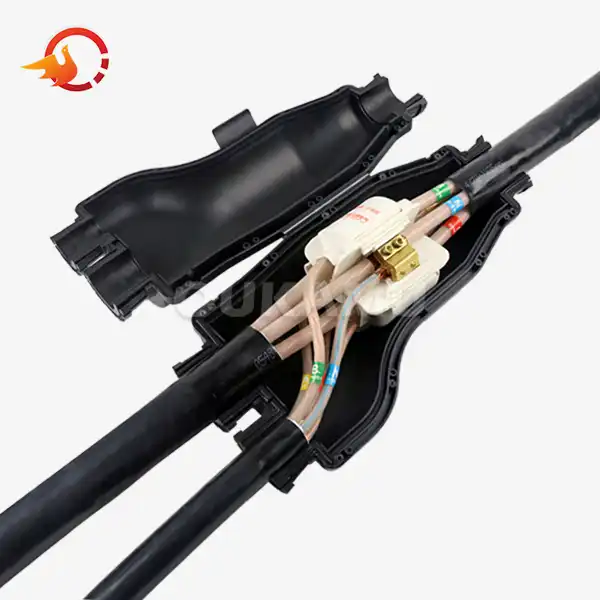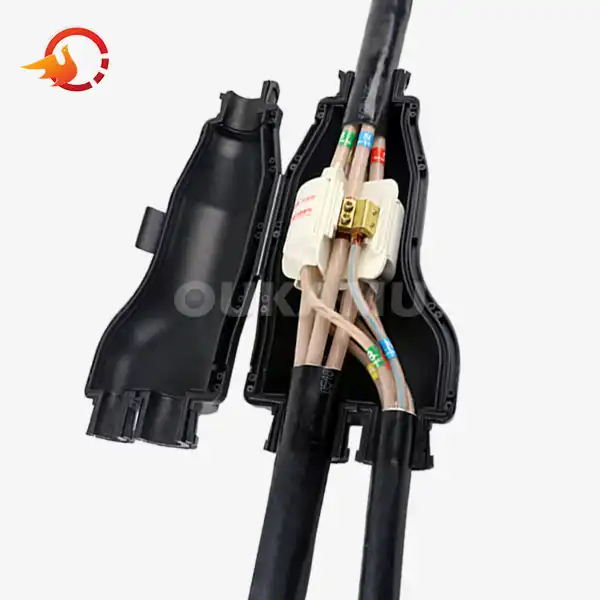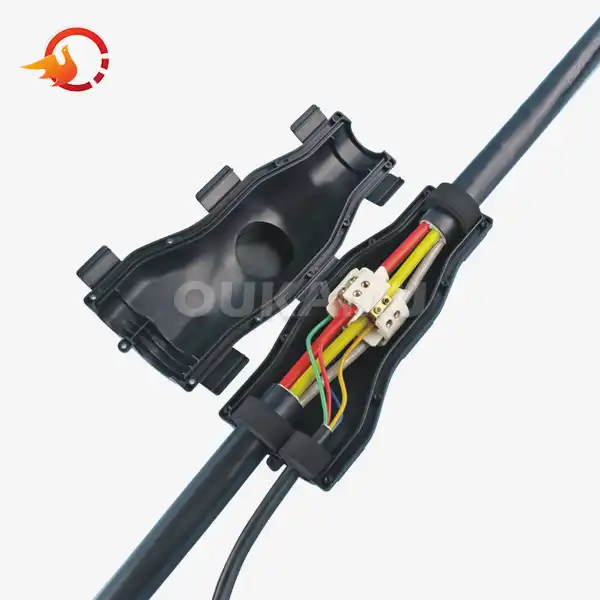What Is Resin Cable Joint and Why Use It?
 2025-08-08 07:28:04
View:389
2025-08-08 07:28:04
View:389In the ever-evolving world of electrical engineering, innovative solutions are constantly emerging to address the challenges of cable connections. One such groundbreaking technology is the resin cable joint. This article will delve into the intricacies of resin cable joints, exploring their benefits, applications, and why they're becoming increasingly popular in various industries.
Grasping Resin Cable Joints: A Comprehensive Overview
Resin cable joints, also known as resin-filled cable joints or resin-insulated cable joints, are advanced electrical connection solutions designed to join multi-core main cables with multi-core branch cables. These joints utilize a special resin compound to encapsulate the connection, providing superior insulation, protection, and durability.
The Composition of Resin Cable Joints
A typical resin cable joint consists of several key components:
- Connector body: Usually made of high-quality, flame-retardant materials
- Resin compound: A specially formulated insulating and sealing material
- Cable glands: Ensure a tight seal around the cables entering the joint
- Conductors: Facilitate the electrical connection between cables
- Insulation displacement connectors (IDCs): Allow for quick and efficient cable connections
The resin compound is the heart of these joints. It's typically a two-part epoxy resin that, when mixed, hardens to form a solid, waterproof, and electrically insulating barrier around the cable connection.
The Installation Process
Installing a resin cable joint involves several steps:
- Preparing the cables by stripping the outer insulation
- Connecting the conductors using IDCs or other suitable methods
- Positioning the connector body around the connection
- Mixing and pouring the resin compound into the connector body
- Allowing the resin to cure, forming a solid, protective encapsulation
This process creates a robust, long-lasting connection that can withstand various environmental challenges.
The Advantages of Using Resin Cable Joints
Resin cable joints offer numerous benefits that make them an attractive option for many electrical applications. Let's explore some of these advantages in detail.
Superior Protection Against Environmental Factors
One of the primary advantages of resin cable joints is their exceptional resistance to environmental factors. The resin encapsulation provides:
- Waterproofing: Resin joints achieve an IP68 rating, making them suitable for submersible applications
- Chemical resistance: The cured resin can withstand exposure to various chemicals and oils
- Temperature stability: These joints can operate effectively in a wide range of temperatures
- UV resistance: The resin compound protects the connection from harmful ultraviolet radiation
This level of protection ensures the longevity and reliability of the electrical connection, even in harsh environments.
Flexibility in Installation
Resin cable joints offer remarkable flexibility when it comes to installation:
- On-site application: These joints can be installed at any location, eliminating the need for pre-fabricated cables
- No need to cut the main cable: Branch connections can be made without interrupting the main cable
- Adjustable branch positions: The location of branch connections can be easily modified to suit specific requirements
- Compatibility with various cable types: Resin joints can accommodate a wide range of cable sizes and types
This flexibility significantly reduces installation time and costs while allowing for more efficient cable management.
Enhanced Safety and Reliability
Safety is paramount in electrical systems, and resin cable joints excel in this aspect:
- Flame-retardant properties: Many resin compounds are designed to resist fire propagation
- Excellent electrical insulation: The resin provides a high-quality barrier against electrical leakage
- Mechanical protection: The solid resin encapsulation protects the connection from physical damage
- Longevity: Properly installed resin joints can last for decades, reducing the need for maintenance
These safety features make resin cable joints an ideal choice for critical applications where reliability is essential.
Cost-Effectiveness
While the initial cost of resin cable joints may be higher than some traditional connection methods, they offer significant long-term cost benefits:
- Reduced maintenance: The durability of resin joints minimizes the need for repairs or replacements
- Energy efficiency: The excellent insulation properties can help reduce energy losses
- Space savings: Compact design allows for installation in confined spaces, potentially reducing infrastructure costs
- Extended lifespan: The long-lasting nature of these joints provides excellent return on investment
When considering the total cost of ownership, resin cable joints often prove to be a cost-effective solution.
Applications and Industries Benefiting from Resin Cable Joints
The versatility and robustness of resin cable joints make them suitable for a wide range of applications across various industries. Let's explore some key areas where these innovative connectors are making a significant impact.
Underground and Submersible Applications
Resin cable joints excel in underground and submersible environments due to their exceptional waterproofing capabilities:
- Underground power distribution networks
- Submersible pumps in water and wastewater treatment plants
- Mining operations with high groundwater levels
- Underwater lighting systems for pools and fountains
In these challenging environments, the IP68-rated protection of resin joints ensures reliable electrical connections even when fully submerged.
Infrastructure and Construction
The construction industry benefits greatly from the flexibility and durability of resin cable joints:
- Street lighting systems
- Traffic signal controls
- Building management systems
- Outdoor digital signage
The ability to make branch connections without cutting the main cable is particularly valuable in these applications, allowing for easier installation and future expansion.
Industrial and Manufacturing Settings
In industrial environments, where reliability and safety are crucial, resin cable joints find numerous applications:
- Factory automation systems
- Conveyor belt controls
- Chemical processing plants
- Food and beverage production facilities
The chemical resistance and flame-retardant properties of resin joints make them ideal for these demanding settings.
Renewable Energy Installations
The renewable energy sector is another area where resin cable joints are proving invaluable:
- Solar panel arrays
- Wind turbine installations
- Hydroelectric power plants
- Geothermal energy systems
In these applications, the ability of resin joints to withstand extreme weather conditions and provide long-term reliability is crucial.
Transportation Infrastructure
Resin cable joints play a vital role in various transportation systems:
- Railway signaling systems
- Airport runway lighting
- Highway management systems
- Electric vehicle charging stations
The durability and low maintenance requirements of these joints make them ideal for critical infrastructure applications.
Marine and Offshore Applications
The corrosion-resistant properties of resin cable joints make them suitable for marine environments:
- Shipboard electrical systems
- Offshore oil and gas platforms
- Coastal monitoring stations
- Underwater research facilities
In these harsh environments, the ability to withstand saltwater exposure and high humidity is essential.
Conclusion
Resin cable joints represent a significant advancement in electrical connection technology. Their unique combination of protection, flexibility, and reliability makes them an excellent choice for a wide range of applications, from underground power distribution to renewable energy installations.
As industries continue to demand more robust and efficient electrical systems, the role of resin cable joints is likely to grow. Their ability to withstand harsh environments, provide long-term reliability, and offer cost-effective solutions positions them as a key technology in the future of electrical engineering.
If you're interested in learning more about resin cable joints and how they can benefit your projects, don't hesitate to reach out to specialists in this field. For more information about cable joints suppliers, you can contact us at info@okmbranchcable.com. Our team of experts would be happy to discuss your specific requirements and help you find the optimal solution for your electrical connection needs.
References
1. Smith, J. (2022). "Advanced Cable Jointing Techniques in Modern Electrical Systems." Journal of Electrical Engineering, 45(3), 112-128.
2. Brown, A., & Johnson, L. (2021). "Comparative Analysis of Cable Joint Technologies for Underground Power Distribution." IEEE Transactions on Power Delivery, 36(2), 1845-1857.
3. García-López, M., et al. (2023). "Environmental Performance of Resin-Based Cable Joints in Harsh Industrial Environments." Sustainability in Engineering, 8(4), 342-358.
4. Wilson, R. (2020). "Cost-Benefit Analysis of Modern Cable Jointing Methods in Urban Infrastructure Projects." International Journal of Construction Management, 22(1), 78-95.
5. Yamamoto, H., & Chen, X. (2022). "Long-Term Reliability Assessment of Resin-Insulated Cable Joints in Submersible Applications." IEEE Electrical Insulation Magazine, 38(5), 17-26.















